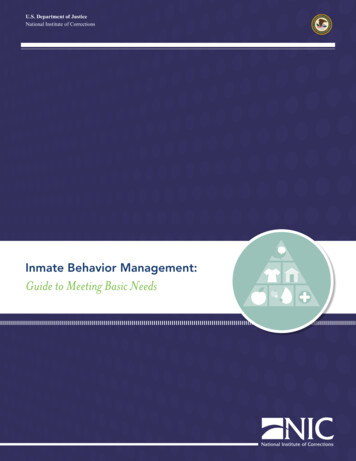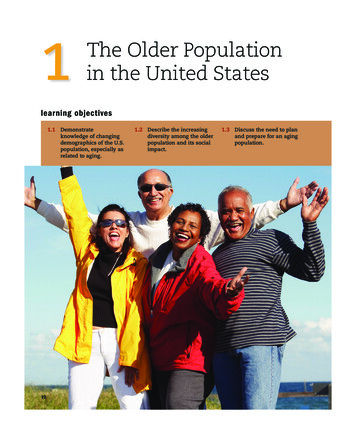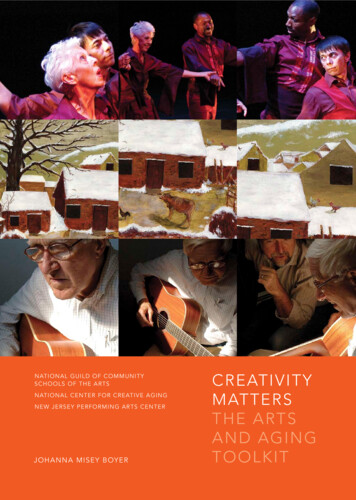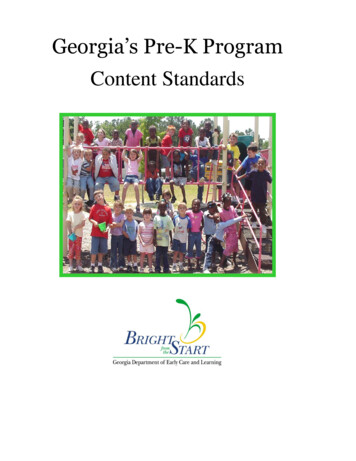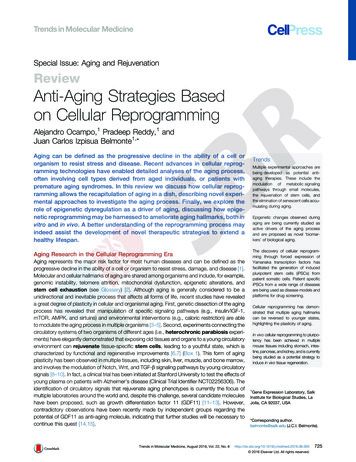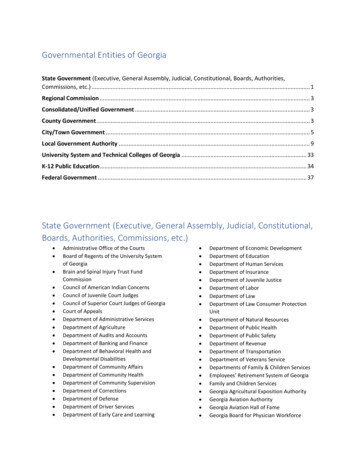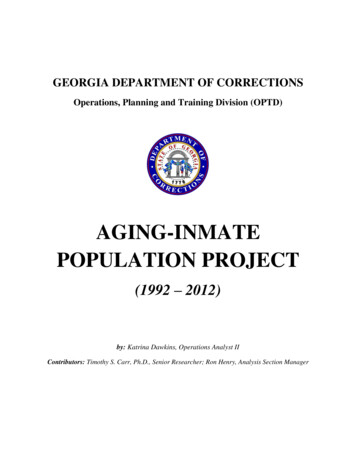
Transcription
GEORGIA DEPARTMENT OF CORRECTIONSOperations, Planning and Training Division (OPTD)AGING-INMATEPOPULATION PROJECT(1992 – 2012)by: Katrina Dawkins, Operations Analyst IIContributors: Timothy S. Carr, Ph.D., Senior Researcher; Ron Henry, Analysis Section Manager
NOTE: All data in this report was collected during thefirst three quarters of 2013 (February – September).These numbers change constantly and may not or will notbe consistent with the numbers we currently have, butwere the correct numbers we retrieved at the time thesereports were created.‘The Aging-Inmate Population Project’Created by Katrina Dawkins, Operations Analyst II for FY 2013 - GDC (OPTD)Page 2
Older inmates have more health problems, generally consume more health services, and areprescribed more medications than younger inmates Regardless of the increased demand theseindividuals place on the system, their numbers are steadily increasing and they will continue toconsume a disproportionate share of the limited resources available for health care andprogrammatic enhancements within the correctional setting.-State of Florida Correctional Medical Authority, “2009-2010 Annual Report and Reporton Aging-inmates”Executive SummaryThe aging-inmate crisis is a major topic of discussions in prison systems throughout America.This crisis is primarily focused on the high cost of caring for the aging-inmate population. Thisis an on-going and growing concern for the state and federal prison systems not only in America,but also outside of U.S, as mentioned in the following,The rising cost and complexity of incarcerating the aged is far from anexclusively American problem. A study released this month in a /volume-1/issue-5) states that “olderprisoners are the fastest growing subgroup in the English and Welsh prisonestate” and that 44 percent of those establishments have no established prisonerpolicies. And so the staff of the prison is left to figure out how to enforce strictprison rules on those who are sometimes physically unable to stand to be counted,walk long distances to dining halls, or get top bunks. ns-is-old-people)California has strict laws for violent felony crimes. It passed the three-strikes law which givesoffenders lengthy mandatory sentences for the third conviction for any felony. Georgia has aneven stricter two-strikes law, although it applies to only the most heinous felonies, includingmurder, aggravated assault, child molestation, aggravated child molestation, armed robbery,kidnapping, and rape. In Georgia, these crimes are collectively called the ‘Seven Deadly Sins’.The elderly are being sentenced to prison for longer periods of time. If an offender commitsmurder as a first offense, he/she will get at a minimum life in prison with the possibility ofparole. If his/her first offense is one of the other six Deadly Sins, he/she will get a mandatoryminimum sentence of ten years; the maximum sentence can be as high as life. A secondconviction, at any time, will result in a sentence of life without parole, therefore, referring to thislaw as the ‘two-strikes’ law. Consequently, many more offenders will stay in prison beyondtheir fiftieth birthday and some will stay for the rest of their lives.The Georgia Department of Corrections (GDC), as well as most other states in the US, is seekingways to adequately accommodate the aging-inmate population, as it relates to their physical andmental state and the medical needs associated with them, while at the same time alleviating thehigh-cost of care. For example, view the Table 1 below.‘The Aging-Inmate Population Project’Created by Katrina Dawkins, Operations Analyst II for FY 2013 - GDC (OPTD)Page 3
STATEGeorgiaMichiganNevadaNorth CarolinaOklahomaTexasVirginiaAGING-INMATEMEDICAL COST 8,500 11,000- 40,000 4,000- 5,000 5,970 6,231 4,853 5,400YOUNGER/HEALTHIERINMATES MEDICAL COST 950 4,200 or less 1,000 1,980 4,911 795 800Table 1: Comparing elderly offender vs. youth offender medical-costThe need for inmates fifty years old or older to receive medical attention and care has drasticallyand steadily increased over the past 20 years and so has the cost of caring for their medicalneeds. In November 2009, according to Stephen ates)Georgia, one of the 10 largest prison systems in the country, spends about 8,500on medical costs for inmates over 65, compared with about an average of 950for those who are younger, corrections officials say. Across the country, inmatemedical care costs about 3 billion a year.Georgia inmates 65 and over had an average yearly medical cost of 8,565 compared with 961for those under 65 years old. Older inmates’ medical cost is nearly nine times higher thanyounger inmates, according to Dave Crary of the Associated Press in the article Elderly inmates:Aging Prison Population Strains Tight State Budget. (2012, January 27)The number of inmates fifty years old or older, who are aging in prison and suffering fromvarious ailments in state prisons nationwide, is increasing. As of 2012, Georgia had more than54,400 inmates and more than 9,100 were fifty years old or older. Five years ago, in 2007,Georgia had 55,600 inmates and just over 7,000 were fifty years old or older. Even though therewere more inmates in 2007 than in 2012, the number of inmates fifty years old or older hasgrown by more than 2,000 since 2007. Ailments that the inmates fifty years old or older sufferwith include heart disease, diabetes, high blood pressure, cancer, Alzheimer’s, dementia, visionand dental issues and other common illnesses associated with growing old.The main reasons why prisons systems are facing this dilemma across the country are the same.The main reasons for the aging-inmate crisis include; laws with mandatory sentencing whichcauses inmates to be incarcerated for longer periods of time; long-term substance-abuse thatcontributes to poor health issues; and years of poor diets and poor eating-habits which alsocontributes to poor health issues.Even though the reasons for this dilemma are the same, the actions that individual states areadopting in order to alleviate the aging inmate crisis, are different from one state to the next. Forexample, California prison officials announced the dedication of an 839 million complex inStockton to provide “mental health and medical services to the state’s sickest inmate patients”,‘The Aging-Inmate Population Project’Created by Katrina Dawkins, Operations Analyst II for FY 2013 - GDC (OPTD)Page 4
according the Johnson and Beiser, USA Today (2013), whereas, “15 states and the District ofColumbia had provisions for geriatric release.” according to Tina Chiu of the Vera Institute ofJustice. Some states see a need to release chronically-ill inmates fifty years old or older to theirfamilies, some states have medical facilities to move them to, some states house them at certainprisons that cater to the sick and in many cases the inmates fifty years old or older simply die inprison before they are ever able to be pardoned or moved to a facility that can care for them.In order for the GDC to continue to effectively care for the fifty years old or older inmatepopulation, it must provide these aging-inmates with the proper needed care in order to be incompliance with the federal government and the U.S. Constitution, while at the same time, adopta highly-effective means of conserving limited funds.‘The Aging-Inmate Population Project’Created by Katrina Dawkins, Operations Analyst II for FY 2013 - GDC (OPTD)Page 5
GRAPH 1: SHIFTING INMATE AGE DISTRIBUTION(Standing Population 1992 – 2012)The overall inmate standing population, over the past 20 years, for the various age groups bydecade are shown in graph 1 (below): The number of inmates in their teens slightly decreasedfrom 3% to 2%; the number of inmates in their 20’s decreased by 7% (from 37% to 30%);inmates in their 30’s also had a 6% decrease in growth (from 34% to 28%). Inmates in their 40’shad a 7% increase (from 13% to 21%); inmates in their 50’s experienced a steady increase intheir population, growing from 3% to 12%, which is a 9% increase; and inmates 60 and over hada slight increase in their standing inmate population, growing by 2% (from 2% to 4%).Even though more than 87% of the standing population in 1992 was under 50 years old andinmates 50 and older accounted for only about 5% of the total population in 1992, by 2012inmates under 50 only made up about 81% of the total standing population (a decrease of about6%) and inmates 50 and older accounted for 16% of the total standing population which is an11% increase since 1992.Today, in the standing inmate population there are considerably more inmates in their fifties andolder than there was 20 years ago. Inmates in their fifties have quadrupled from 3% - 12% andinmates 60 and older have doubled from 2% - 4%.Age Composition of Prison Population(1992-2012)100%90%80%70%50 Pop60%40'SPop50%30'S Pop40%20'S Pop30%Teens Pop20%10%‘The Aging-Inmate Population Project’Created by Katrina Dawkins, Operations Analyst II for FY 2013 - GDC 20012000199919981997199619951994199319920%Page 6
GRAPH 2: AVERAGE INMATE AGE INCREASINGThe average (mean) age of the GA inmate has steadily increased over the past 20 years. Asreflected below, the average inmate age has increased during the past 20 years by more than 4years, from 33.2 to 37.5 years.Mean Age in the Standing Inmate Population(1992-2012)36.5 36.735.234.435.737.337.536.234.9‘The Aging-Inmate Population Project’Created by Katrina Dawkins, Operations Analyst II for FY 2013 - GDC .2 33.333.834.735.436.036.837.1 37.1 37.2Page 7
GRAPH 3: ADMISSION TRENDSThere were 2,124 inmates, age fifty and over (or 10% of all admissions that year), admitted toGeorgia prison in FY 2012. FY 2012 had the record high of admissions over the past 20 years.The FY 2012 admissions of older inmates was nearly three times higher than FY 2002 (10 yearsago) and nearly 4 times higher than in FY 1992 (20 years ago).Inmates Age 50 and Older Admitted to Prison byCalendar 4(1992 - 2012)500‘The Aging-Inmate Population Project’Created by Katrina Dawkins, Operations Analyst II for FY 2013 - GDC 97FY1996FY1995FY1994FY1993FY19920Page 8
GRAPH 4: ADMISSION TYPESMore than three-fourths (over 77%) of all inmates age 50 and older are admitted to prisonthrough a direct court commitment (or new from court) whereas 16% are parole revocations andremaining 6% are probation revocations.Admission Types of Younger and OlderInmates19,844(1992 - 2012)16,377New cation2,854611Fifties3,0342,222362459317 26 46 389SixtiesSeventies3,2441,12326 2 7 35EightiesTotalAdmissionType byDecadeTotal AdmissionTypeCHART 4: ADMISSION TYPES (%)Age 50 and Older(1992 - 2012)New from CourtParole RevocationProbation RevocationTotal Admission Type enties81%7%12%100%Eighties74%6%20%100%Total 9,844‘The Aging-Inmate Population Project’Created by Katrina Dawkins, Operations Analyst II for FY 2013 - GDC (OPTD)Page 9
GRAPH 5: CRIME TYPESThe inmate cohort age 50 and older in the standing inmate population is less violent than inmatesin the teens, twenties, thirties and forties cohorts, but there are more sex offenders in the 50 andolder cohort than inmates in the teens, twenties, thirties and forties cohorts. 55% of inmates 50and older are serving sentences for violent and sex crimes.Standing Population Inmates Age 50 and Older(March 2013)Alcohol, 0, 0%DrugPossession/Sales,659, 15%Habit/DUI, 19, 0%Viol/Persn, 1397,31%NViol/Persn, 2, 0%Other, 206, 4%Sex Offender, 1072,24%‘The Aging-Inmate Population Project’Created by Katrina Dawkins, Operations Analyst II for FY 2013 - GDC (OPTD)Property, 1160,26%Page 10
CHART 6: CONVICTION OFFENSESOf the 4,515 inmates age 50 and older in the standing inmate population as of December 3, 2012,about one-third (1,498) were serving sentences for the offenses of murder, child molestation,aggravated assault, aggravated child molestation or rape.Inmate Standing Population Most Common ConvictionOffenses for Inmates 50 and Older(March 2013)Aggrav Assault,415, 9%Aggrav ChildMolestation, 168,4%ChildMolestation, 490,11%Murder, 314, 7%Other, 3017, 67%‘The Aging-Inmate Population Project’Created by Katrina Dawkins, Operations Analyst II for FY 2013 - GDC (OPTD)Rape, 111, 2%Page 11
GRAPH 7A: DETERMINATE SENTENCELENGTHSGiven the severity of the offenses for which a majority of inmates age 50 and older are servingprison time, it follows that the age 50 and older cohort has longer sentence lengths as comparedto other age groups. More than 43% of seniors in their fifties and nearly 34% of inmates in the60 and older cohort are serving sentences less than 10 years. On the other hand, nearly 57% ofseniors in their fifties and more than 66% of seniors 60 and older are serving sentences of 10years or longer. Almost 49% of inmates in their forties are serving sentences less than 10 yearsand nearly 52% of inmates in their forties are serving sentences of 10 years or more. As forinmates in their thirties, 53% are serving sentences under 10 years and 47% are serving sentencesof 10 years or more; nearly 66% inmates in their twenties are serving sentences less than 10years and over 34% are serving sentences of 10 years or more. Lastly, nearly 83% of inmates intheir teens are serving sentences less than 10 years and over 17% of teens are serving sentencesof 10 years or more.Percent of Inmates by Age Group: DeterminateSentence Lengths Under and Over 10 Years(March 34.2%a. 10 yrs33.7%b. 10 Yrs17.3%TeensTwentiesThirtiesFortiesFifties‘The Aging-Inmate Population Project’Created by Katrina Dawkins, Operations Analyst II for FY 2013 - GDC (OPTD)Sixties Page 12
GRAPH 7B: DETERMINATE SENTENCELENGTHSInmates in their teens have an average sentence length of 6.02 years; inmates in their twentieshave an average sentence length of 7.98 years; inmates in their thirties have an average sentencelength of 9.73 years; inmates in their forties have an average sentence length of 10.72 years;inmates in their fifties have an average sentence length of 11.59 years; and inmates 60 and olderhave an average sentence length of 13.85 years.Average Sentence in Years in the StandingInmate Populaton(March 2013 - by Age rtiesForties‘The Aging-Inmate Population Project’Created by Katrina Dawkins, Operations Analyst II for FY 2013 - GDC (OPTD)FiftiesSixty Page 13
GRAPH 8: INMATES SERVING LIFEAND LIFE WITHOUT PAROLE (LWOP)As of March 2013, there were 2,436 inmates age 50 and older serving sentences for either lifeor life without parole. Inmates in their thirties and forties combined, have a greater potentialfuture effect on the aging of the inmate population due to their sheer number; in March 2013there were a combined number of 4,578 inmates in the two age groups serving life or lifewithout parole sentences. There are an additional 1,017 inmates in the combined age groupsof the teens and twenties serving these sentences.Inmates Serving Life and Life w/o Parole(March 989579773621 7 Sixty Age by DecadeCurrent Age by DecadeTeensTwentiesThirtiesFortiesFiftiesSixty Life218952,1331,9691,4677367,221Life w/oParole79423524117261810‘The Aging-Inmate Population Project’Created by Katrina Dawkins, Operations Analyst II for FY 2013 - GDC (OPTD)Total289892,3682,2101,639797Page 14
CHART 9: 50 AND OLDER INMATES IN THESTANDING POPULATIONThe number inmates 50 years old and older has nearly tripled over the past 10 years and nearlyquadrupled over the past 20 years.Number of Inmates 50 and Older in StandingPopulation by Fiscal Year(1992 - �The Aging-Inmate Population Project’Created by Katrina Dawkins, Operations Analyst II for FY 2013 - GDC (OPTD)FY 2012FY 2011FY 2010FY 2009FY 2008FY 2007FY 2006FY 2005FY 2004FY 2003FY 2002765FY 2001FY 1999FY 1998FY 1997FY 1996FY 1994530FY 1993FY 1992545542 621 544 610FY 19955761,001874724FY 2000798Page 15
GRAPH 10: INMATE INSTITUTIONAL ASSIGNMENTS (1)Georgia houses prison inmates in primarily four types of facilities: state prisons, private prisons,transition centers and county correctional institutions. The majority of prisoners are housed instate prisons (40,470) followed by private prisons (8,504), county correctional institutions(5,140), then by transitional centers (2,704).The groups that consistently dominate the largest population in all of the four types of prisons areinmates in their twenties and those in their thirties. Most inmates are housed in state prisons.The highest concentration of inmates, age 50 and over, are housed in the Georgia DiagnosticClassification Prison. Approximately 438 of the average daily population at Georgia DiagnosticClassification Prison are in the 50 or older age range.PLEASE REFER TO CHART 10: INMATES INSTITUTIONAL ASSIGNMENTS ON THENEXT PAGE‘The Aging-Inmate Population Project’Created by Katrina Dawkins, Operations Analyst II for FY 2013 - GDC (OPTD)Page 16
CHART 10: INMATE INSTITUTIONAL ASSIGNMENTS (2)Inmate CurrentInstitution Name# of Inmates50 and OlderCurrentInstitutionType DescGa Diag Class Prison438State PrisonAugusta State Med. Prison228State PrisonJohnson State Prison228State PrisonWheeler Corr Facility214Private PrisonCoffee Corr Facility202Private PrisonCoastal State Prison186Calhoun State Prison182Autry State PrisonDooly State PrisonInmate CurrentInstitution Name# of Inmates50 and OlderCurrentInstitutionType DescAtl. Transitional Ctr (M)19Trans CtrValdosta Tc18Trans CtrCoastal Tc17Trans CtrFloyd County Ci16County CIMuscogee County Ci16County CIState PrisonMetro Transitional Ctr14Trans CtrState PrisonTroup County Ci14County CI169State PrisonMacon Transitional Ctr (M)13Trans Ctr166State PrisonCoweta County Ci12County CIWilcox State Prison159State PrisonLagrange Tc11Trans CtrGa State Prison152State PrisonClayton County Ci10County CIWashington State Prison137State PrisonSumter County Ci10County CIDodge State Prison132State PrisonBulloch County Ci9County CIPulaski State Prison121State PrisonJefferson County Ci9County CIArrendale State Prison117State PrisonMitchell County Ci9County CICentral State Prison115State PrisonScreven County Ci9County CIRiverbend Corr Facility106Private PrisonCarroll County Ci8County CIValdosta Sp106State PrisonHall County Ci8County CIHays State Prison103State PrisonAlbany Transitional Ct7Trans CtrMacon State Prison100State PrisonAugusta Tc7Trans CtrJenkins Corr Facility99Private PrisonColumbus Tc7Trans CtrRogers State Prison96State PrisonDecatur County Ci7County CIWare State Prison91State PrisonHelms Facility7State PrisonPhillips State Prison89State PrisonThomas County Ci7County CILee State Prison75State PrisonTerrell County Ci6County CIRutledge State Prison73State PrisonClarke County Ci5County CIBaldwin State Prison72State PrisonGwinnett County Ci5County CIHancock State Prison67State PrisonHarris County Ci5County CITelfair State Prison64State PrisonWest Central4RSAT - CenterSmith State Prison54State PrisonColquitt County Ci3County CIBurrus Corr Trn Cntr43State PrisonJackson County Ci3County CIEmanuel - Swainsboro40State PrisonEffingham County Ci2County CIMontgomery State Prison40State PrisonRichmond County Ci2County CIWalker State Prison37State PrisonBibb County1County JailWhitworth Facility30State PrisonHaralson County1County JailLong28State PrisonHenry County1County JailSpalding County Ci24County CIMetro State Prison (W)1State PrisonClayton Tc20Trans CtrSmith T.C1Trans CtrSPALDING COUNTY1County Jail‘The Aging-Inmate Population Project’Created by Katrina Dawkins, Operations Analyst II for FY 2013 - GDC (OPTD)Page 17
GRAPH 11: PHYSICAL PROFILEInmates without major defects made up 58.2% of the population. 41% of inmates 50 and olderrepresented the next largest group which had no physical limitations. Less than 1% of inmateshave a major defect and less than 1% of inmates have a very major defect.Standing Count for Inmates 50 and Older(April 2013)Very Major, 5,0.1%No Limit, 1,931,41.0%‘The Aging-Inmate Population Project’Created by Katrina Dawkins, Operations Analyst II for FY 2013 - GDC (OPTD)Defect - Major,32, 0.7%Defect - NotMajor, 2,740,58.2%Page 18
CHART 12: SUPERVISION LEVELCLASSIFICATIONAccording to this report, 9.3% of the 50 and older inmate cohort is classified as close comparedto 60.1% which are classified as medium and 30.6% are classified as minimum security risk.The older inmate cohort is less likely than all of the other cohorts, with the exception of theteens, to be classified as close or medium security.Standing Count - Inmates Age 50 and Older(April 2013)Minimum, 2,630, 30.6%Close, 794 , 9.3%Medium, 5,158 ,60.1%‘The Aging-Inmate Population Project’Created by Katrina Dawkins, Operations Analyst II for FY 2013 - GDC (OPTD)Page 19
THE AGING-INMATE POPULATIONinthe SOUTHEASTERN REGIONSTATETOTALPOPULATION50 POPULATIONPERCENTAGEOFPOPULATION50 North Carolina38,3856,03016%South 148,82427,25819%Virginia29,7406,28321%‘The Aging-Inmate Population Project’Created by Katrina Dawkins, Operations Analyst II for FY 2013 - GDC (OPTD)Page 20
a highly-effective means of conserving limited funds. . Teens Pop GRAPH 1: SHIFTING INMATE AGE DISTRIBUTION . from 3% to 2%; the number of inmates in their 20's decreased by 7% (from 37% to 30%); inmates in their 30's also had a 6% decrease in growth (from 34% to 28%). Inmates in their 40's


